Einleitung
Diese Anleitung zeigt dir, wie du die Festplatte des Mac mini komplett austauschen kannst.
Beachte, dass einige der empfindlichen Verbindungen in diesem Mac schwer zu lösen und noch schwieriger wieder anzuschließen sind, als in anderen Macs. Die Anleitung erklärt umfassend, wie sich jedes einzelne Teil, das dem Ausbau der Festplatte im Weg steht, ausbauen lässt. Erfahrene Reparierer können vielleicht Zeit sparen, wenn sie den Lüfter und die Antennenplatte aus dem Weg schieben, ohne sie abzutrennen.
Werkzeuge
Ersatzteile
-
-
Mit den Daumen in die Vertiefungen der Bodenplatte drücken.
-
Die Bodenplatte jetzt gegen den Uhrzeigersinn drehen, bis der weiße Punkt mit der Markierung auf dem Außengehäuse übereinstimmt.
-
-
-
Den Mini leicht kippen, damit sich die Bodenplatte vom Gehäuse löst.
-
Bodenplatte entfernen und beiseite legen.
-
-
-
Entferne die beiden 11,3 mm T6 Torx Schrauben, die den Lüfter auf der Platine nahe der Funkantenne festhalten.
-
-
-
Hebe die Öse des Lüfters, die dem RAM am nächsten liegt, von dem am äußeren Gehäuse befestigten Abstandshalter ab.
-
-
-
Nimm den Lüfter aus dem Mini heraus, sodass du ohne Probleme an die Anschlüsse kommst.
-
Fasse alle Lüfterkabel auf einmal und ziehe sie vorsichtig senkrecht nach oben, um den Lüfter vom Logic Board abzutrennen.
-
Entferne den Lüfter.
-
-
-
Entferne die einzige 3,5 mm T6 Torx Schraube, mit der die Haube am Kühlkörper befestigt ist.
-
-
-
Hebe die Haube an der Seite an die dem Antennenblech am nächsten liegt.
-
Drehe sie vom Gehäuse weg und ziehe sie ab.
-
-
-
Entferne folgende Schrauben, die das Antennenblech am Mini festhalten:
-
Zwei 6,6 mm T8 Torx Schrauben
-
Zwei 5,0 mm T8 Torx Schrauben oder 2,0 mm Sechskantschrauben (beide Schraubendreher funktionieren)
-
Beachte beim Zusammenbau:
-
-
-
Hebe das Antennenblech leicht von der Seite her an, die am nächsten am RAM liegt.
-
Ziehe das Blech vorsichtig von der kreisförmigen Rille des Gehäuses weg.
-
-
-
Mit der Spitze eines Spudgers löst du vorsichtig den Antennenverbinder aus seinem Sockel auf der AirPort/Bluetooth Platine.
-
-
-
Mit dem flachen Ende eines Spudgers kannst du den den Stecker der Festplatte aus seinem Anschluss auf der Hauptplatine lösen.
-
-
-
Mit der Spitze des Spudgers kannst du den Stecker des Infrarotsensors aus seinem Anschluss auf dem Logic Board lösen.
-
Dieser Stecker ist sehr empfindlich, hebe ihn sehr vorsichtig und gleichmäßig heraus.
-
-
-
Entferne folgende drei Torx Schrauben:
-
Eine 5,0 mm T8 oder 2,0 mm Hex Schraube (beide Schraubendreher gehen)
-
Eine 16,2 mm Torx T6 Schraube
-
Eine 26 mm Torx T6 Abstandsschraube
-
-
-
Setze das Mac Mini Logic Board Removal Tool in die beiden rot markierten Öffnungen ein. Beachte, dass dass es das Gehäuses unterhalb der Platine berührt bevor du weitermachst.
-
Ziehe das Tool vorsichtig in Richtung der I/O Platine. Die Hauptplatine und die I/O Einheit sollten etwas aus dem äusseren Gehäuse herausrutschen.
-
Ziehe das Mac Mini Logic Board Removal Tool wieder heraus.
-
-
-
Drücke gleichzeitig die beiden Klammern ganz links und rechts an der I/O Einheit zur Mitte des I/O Boards hin und ziehe das I/O Board aus dem Gehäuse.
-
Ziehe das Logic Board nur so weit aus dem Gehäuse, bis die Kante des I/O Boards etwa 1,3 cm von der Kante des Aluminiumgehäuses entfernt ist.
-
-
-
Entferne das Festplattenkabel.
-
Drehe die beiden 6,2 mm T8 Schrauben auf der Seite der Festplatte heraus.
-
-
-
Löse vorsichtig die Abdeckung von der Festplatte ab.
-
Die Festplatte ist frei.
-
Wenn du eine neue Festplatte einbaust, hilft dir unsere OS X Installationsanleitung sie zum Laufen zu kriegen.
-
Um dein Gerät wieder zusammenzusetzen, folge den Schritten in umgekehrter Reihenfolge.
51 Kommentare
Just a note, the OS X Install Guide is for 10.5 Snow Leopard. Maybe also include a install guide for 10.6 Lion?
Sherman -
That's right, steps 10-11 and 13-16 are not necessary.
It suffices to rotate the antenna plate out of the way without detaching its cable.
And after disconnecting the hard drive you can wiggle it out of the enclosure
without dealing with the logic board. Muc less hassle, and much less intimidating.
This is great advice! It worked fine for me, thanks!
This also worked for me. Follow machobbes advice - whole process took about 10 minutes. Easy peasy.
The one difficulty I had was getting the new SSD (or HDD) to lock back into the fixings inside of the casing. Best solution if you are having this problem is to turn the Mini upside down, ensuring that the antenna cable isn't stretched too far, and aided by the wonderful powers of gravity, get the new HDD unit fixed into place properly.
Good advice. I too just moved the antenna plate to the side and the drive was easily accessible.
work great for me! Ty for the tips!
Very useful guide. Keep up the good work ! I have replaced the hard drive on my Mac Mini mid-2011 with a Vertex 3 SSD, and to my surprise I did not have to mess with the logic board (step 13 onwards) to slide-in the new drive. So it took me less than 20 minutes to do the whole thing. After that, recovering the whole system from Time Machine was a breeze.
Fabio -
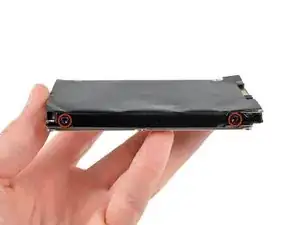
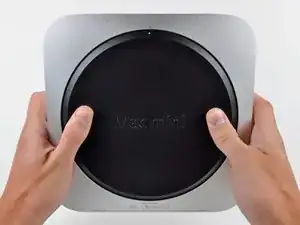
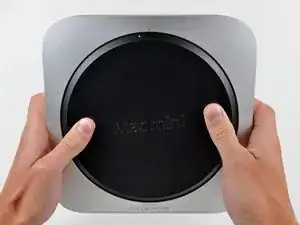

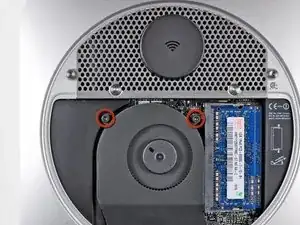
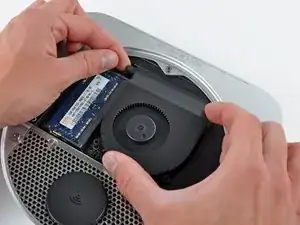
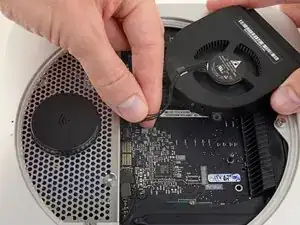
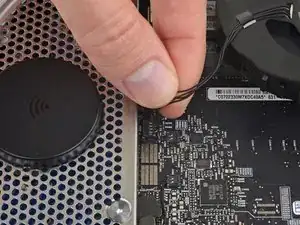
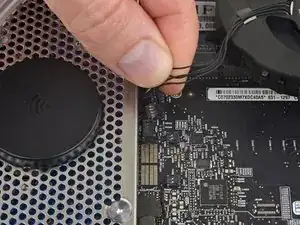
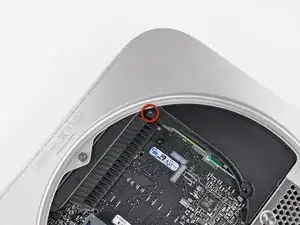
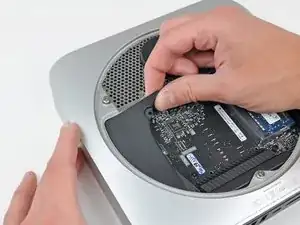
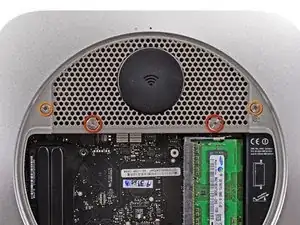
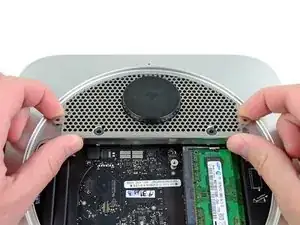
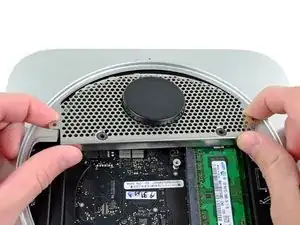
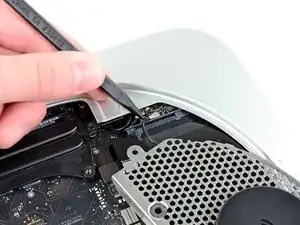
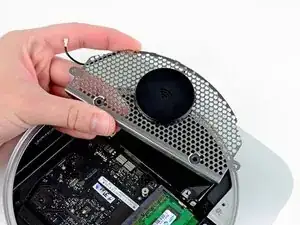
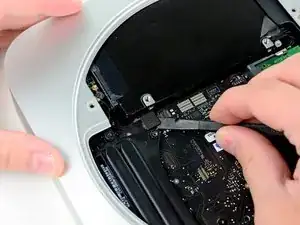
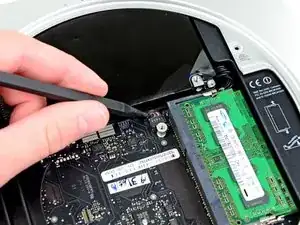

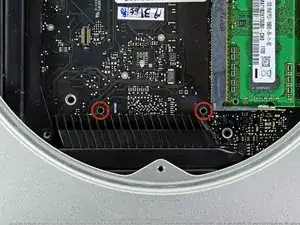
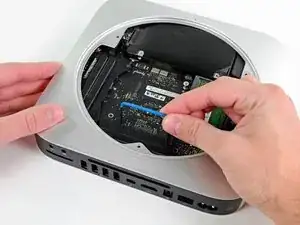
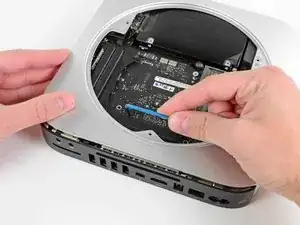
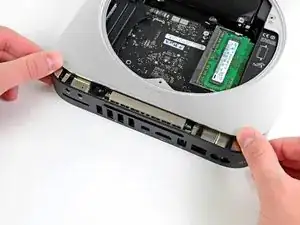
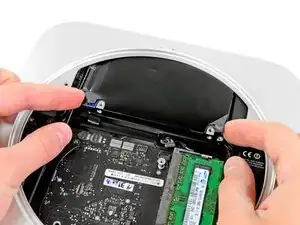

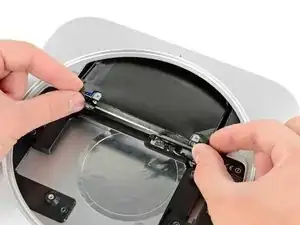
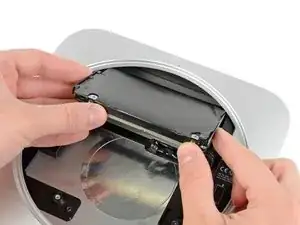
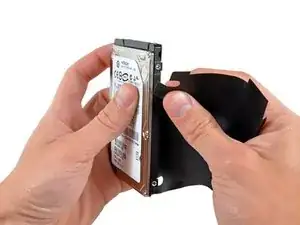

This took a lot of force on my Mac mini. A lot.
nh3 -
I agree. It took a crap ton of force from my thumbs to twist the bottom off.
sleeve -
I accidentally broke the little things that hold the cover to the case. Is there a cheap replacement to the cover? Those clips are held onto it very weakly.
Jacob Halton -
Don't just use your thumbs... Use your whole palm to twist it, with maybe a thumb in one of the recesses, applying slight downward pressure.
markbart -
Wish I would have read this comment before I did it!
I found that what markbart said works best. one palm one thumb (and my knees) My thumbs would do it. It was a bit at a time.
Same difficulty getting it back on.
Would be handy if this (difficulty) was mentioned in the guide
Also would be nice to mention the safe practice of pressing the power button for a few seconds after disconnected to rid the system of any residual power, working in a clean static free environment & they say on the crucial website to touch a metal surface of the machine before touching the RAM
Nancy -
I think it depends, I have seen some that are very difficult to open and some super easy. But I see them everyday. I wish there was a tool that fit in the holes.
Justin Weathersbee -
When seating the bottom RAM chip you may have to apply a little extra side force to get it to seat properly. I put in the new RAM and just got a beeping sound upon starting. I then put the old RAM back in and got the same result.
Here is the solution I found on the Apple discussion board.
"Take a small flat head screwdriver and after you put the memory in slot 0, put the screwdriver between the top of the mac mini and the memory then turn the screwdriver a little to exert pressure on the memory into the slot. Do it on both sides of the memory."
This worked for me.
littlemas2 -
I remember this when I was changing my memory ... I realized (after opening) that more you push, more force it take to open the cover. As you push down you force the cover "to rub" the casing and possibly other things inside. If you "lightly" hold the cover it comes right off ... Remember: less is more! :-)
Have fun!
Radek -
We found it hard to use the thumbs but if you put the casing on a carpet and one person is holding the case while the other is using his palm of one hand to turn the cover it comes off quite smoothly and without much downward pressure.
Alexander -
If you're upgrading to an SSD, before you even take this first step, I'd recommend putting the SSD into an external drive case, using USB and format the SSD first before trying to swap your existing hard drive or implementing a fusion drive. The external drive case will come in handy later so you can use the old drive as extra storage anyhow.
Once that SSD is internal, the Mac errors out during the formatting process. Once it was formatted externally, then installed inside the Mac again, there was no problem.
Orange Girl -
The first time I did this it hurt! The second time my mac mini 2012 had been running so was warm. VERY EASY WHEN WARM. No fun when cool!
Nancy -
Forget about those 2 circle indents. if you consider the 2 marked dots (open and close) as position 12 o’clock, place your thumbs at 11 and 1 o’clock on the outer rim of the cover and rotate from that position.
juicer52 -
No way was I getting the back off. So I made a tool. Took a large wrench longer than the Mac mini. Superglued 2 rubber feet on the wrench at the same location as the thumb indents. Put the Mac on the ground, between my knees and used my body weight to turn the cover. Worked like a charm.
Mark -